'It was awesome growing up down there': Last two houses in downtown Akron to be demolished
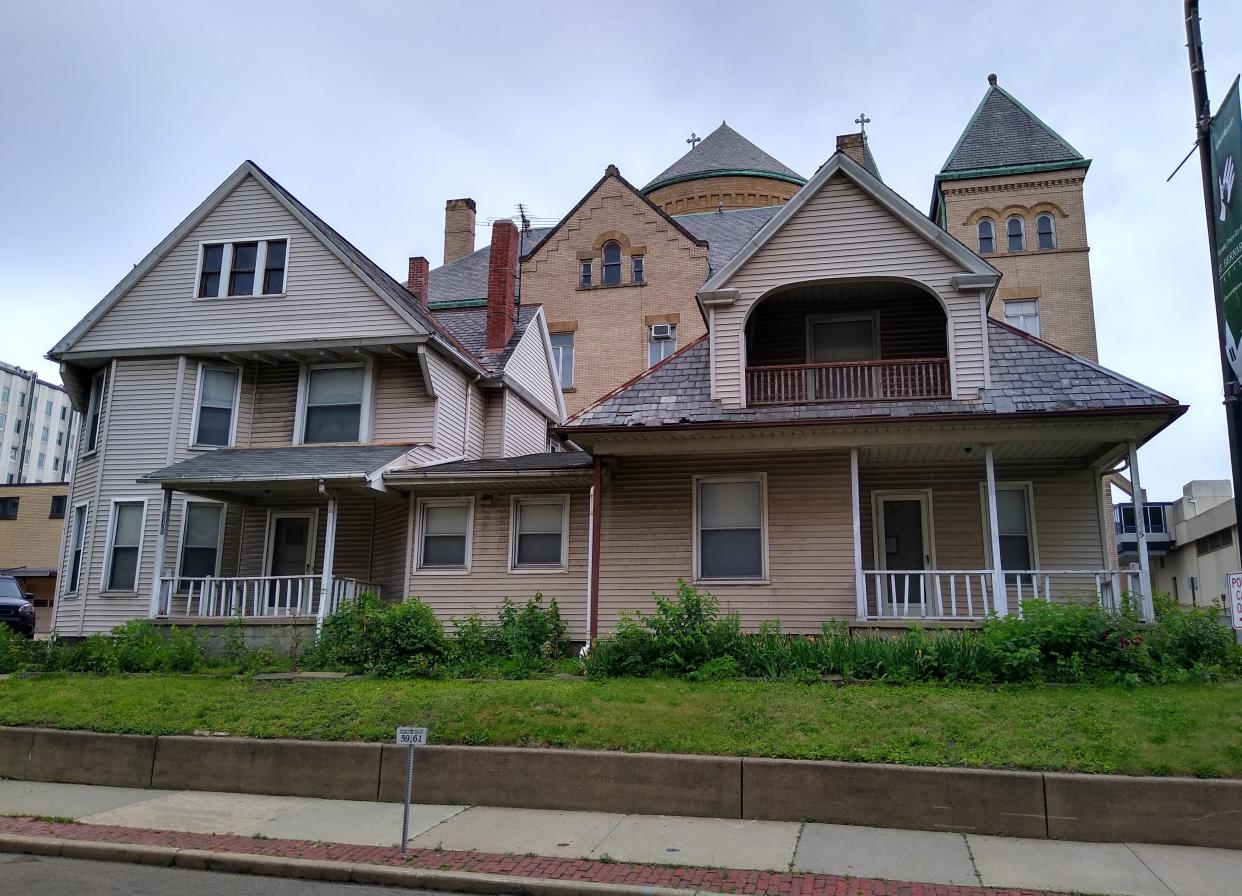
The last two houses in downtown Akron will be torn down this summer.
Located behind St. Bernard Catholic Church, the two-story dwellings are nearly 125 years old and have served many uses over the decades, including convent buildings, caretaker quarters and a women’s shelter.
Local history: Springfield Township landmark is anything but run of the mill
“They are condemned,” explained the Rev. Christopher Zerucha, who has served as pastor of St. Bernard and St. Mary parishes since January 2019. “They’re uninhabitable from the perspective of the fire department.”
The weather-beaten houses stand at 245 and 249 S. High St. on a hill overlooking the University of Akron’s Polsky Building. They are on the block between University Avenue and State Street, north of the Polsky parking deck and south of the Harold K. Stubbs Justice Center.
A covered walkway connects the two structures, creating the illusion of a single dwelling to passing motorists and pedestrians. Church officials refer to the vacant property as “the rental house.”
“We’re looking to knock the house down and make it a green space for now,” Zerucha said. “Should the day arise when somebody else has another thought, we’ll go forward at that point.”
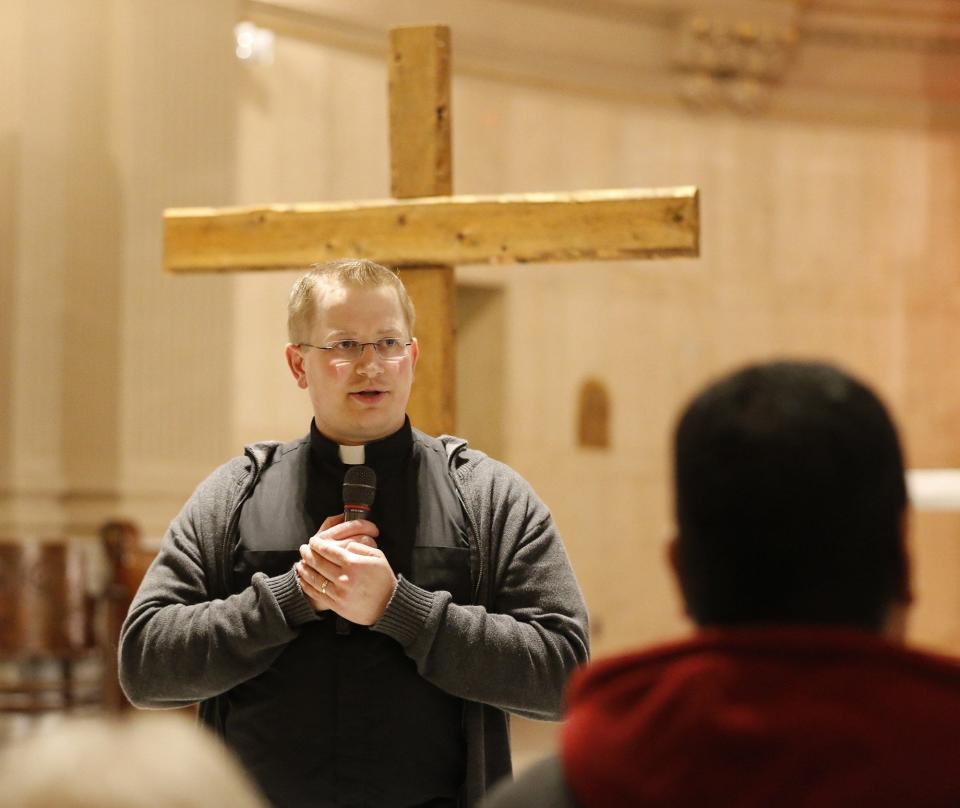
Benny Hengle, 64, of Strongsville, who lived at 245 S. High when his father worked as a custodian at St. Bernard in the 1960s and 1970s, was sorry to hear that his childhood home will be razed.
“It was awesome growing up down there,” Hengle said. “It was absolutely phenomenal.”
He lived in the house with his parents, Frank and Nettie Hengle, and sisters Kathy and Judy. His uncle and aunt, George and Mary Hengle, lived next door.
“It was the only house in downtown Akron,” Hengle said.
Kathy Hengle Harlan, 70, of Green, said the family had a lot of fun at the residence.
“I just went past there not too long ago and I thought, ‘Boy, it just doesn’t look like anybody’s keeping it up,’ ” she said. “Well, now I know why.”
Akron houses built in 1890s
A century ago, hundreds of single-family homes were located downtown before commercial development took over. The frame houses behind St. Bernard are the last ones remaining.
Victoria Ramey, public service assistant at Akron-Summit County Public Library’s Special Collections Division, researched the two homes and traced their construction to the late 19th century.
William McKinley was U.S. president, the nation had 45 states and Akron was a muddy town of less than 43,000 residents. Horse-drawn carriages rolled along High Street and wooden boats navigated the Ohio & Erie Canal two blocks west.
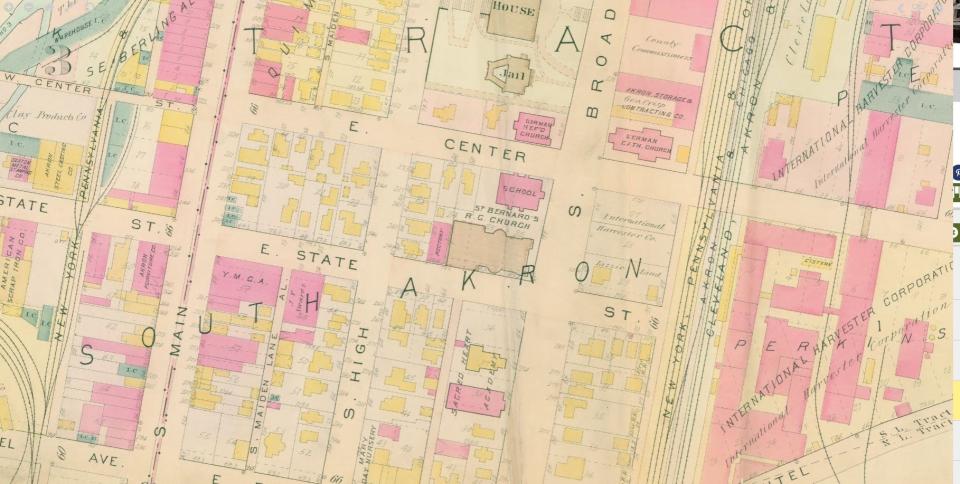
After examining Summit County Fiscal Office records, Sanborn Fire Insurance Maps, Akron city directories and county plat maps and atlases, Ramey concluded that 245 S. High was built in 1897 and 249 S. High was built in 1898.
Civil War veteran William Shauf and his wife, Anna, proprietors of Shauf Candy Kitchen on South Main Street, were the first residents of the home on the left. Dr. David H. Lewis and his wife, Clara, owned the home on the right.
The addresses originally were 507 and 509 S. High St., but the city renumbered the streets in 1903. The houses are older than the magnificent church that looms over them.
Founded in 1861 as a German parish, St. Bernard’s congregation moved across South Broadway into the twin-towered, Romanesque building in 1905. The adjacent St. Bernard School, which operated from 1887 to 1979, was demolished in 2013.
Dwellings have served many uses
The side-by-side houses served many purposes during the 20th century. In addition to family residences, the buildings housed the Catholic Service League, Catholic Community House and Edna Marie Beauty Shop before the church bought them.
The Sisters of St. Dominic moved into the dwellings in the late 1940s and resided there until 1965 when a new convent was built next door.
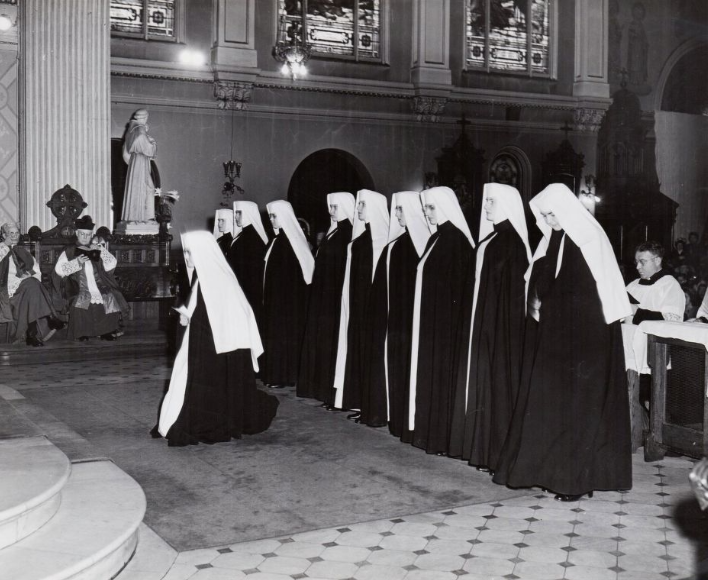
Brothers Frank and George Hengle, who worked as custodians at St. Bernard, moved their families into the houses after the nuns packed up.
“It was a pretty cool home,” Benny Hengle recalled. “The woodwork and all that was just so beautiful.”
Local history: Hollywood star David McLean, who played Marlboro Man, was an hombre from Akron
Downtown was a bustling place with bright lights, heavy traffic, honking horns and occasional sirens.
“We didn’t have air conditioning, so your windows were open,” Hengle said. “But you got so used to the noise. When we would go and visit somebody, like we had friends in Pennsylvania, it was hard as hell to sleep because it was too quiet.”
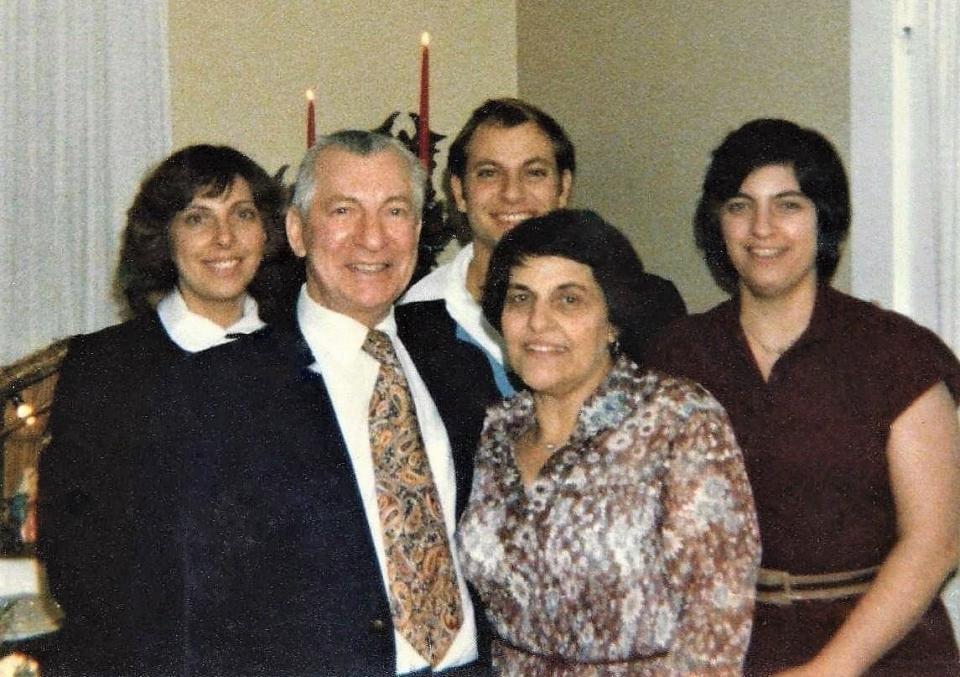
A whirlwind of memories
He and his sister Kathy Hengle Harlan shared a whirlwind of memories about their childhood home.
“We just had a good time,” Harlan said. “We did a lot of family things together.”
Hengle remembers nuns playing basketball in full habits at a hoop on the side of the house. Harlan liked to bounce tennis balls off the church. The Rev. John Mueller played follow the leader with the kids. The Rev. Joseph Stolz came over at night to play cards.
“He’d sit out on our porch, watch the traffic go by, have a stogie and read his Bible,” Hengle said.
“I remember all the sisters and talking to them,” Harlan said.
The kids attended St. Bernard School and Central High School, later Central-Hower.
“I would go up and help my dad clean after school, mop the floors,” Harlan said. “It was a family thing. My dad was very happy working there.”
The kids pretty much had the run of downtown. Hengle and his childhood friends liked to frolic in the department store across the street.
Hide-and-seek at Polsky’s
“I literally knew Polsky’s like the back of my hand so we would give a person three minutes and play hide-and-go-seek,” he said. “That was my playground. I mean, it was awesome.”
Harlan remembers how the family used to sit on the front porch in the evening to watch the ebb and flow of traffic.
“Every time it was 9 o’clock, time for the stores to close, we’d go out on the front porch and watch everybody get picked up,” she recalled. “It was something very simple but very cool.”
Hengle recalls walking down to the Sheraton Hotel every summer to catch a glimpse of Soap Box Derby celebrities such as the television casts of “Bonanza” and “Bewitched.”
“Elizabeth Montgomery twitched her nose at me,” he said.
He remembers going to $1 movie nights at the Civic Theatre, buying candy at the Peanut Shoppe and gazing into the department store windows every Christmas.
“We used to go down there and it was just magical,” he said.
Harlan remembers walking to cheerleading practice at Central, sunning herself on the roof of the covered walkway between the Hengle homes and buying soft drinks at the Greyhound station on Broadway.
The South High address was convenient for shopping.
“We always got the bargains,” Harlan said. “We were always down there first.”
Harlan got her first job at Scotts 5 & 10 at State and Main streets and had to wake up early each day for work.
“My dad would get up in the morning and walk me down the hill to go open the store,” she said. “He didn’t want me to go by myself.”
After their father retired from St. Bernard around 1978, the family moved from the custodian quarters into a Hurlburt Avenue home that they had rented out to others.

Shelter operated in homes
In 1984, Access Inc. converted the South High Street buildings into a shelter for homeless women and children.
“Today, the Akron community has taken a giant step toward providing a much-needed service for homeless women — a service that will provide shelter and dignity to women in crisis,” Sister Jordan Haddad, board president of Access, announced at the opening.
Access Inc. moved its 30-bed shelter to West Market Street in 1996 but operated Step II, a transitional housing program, at the High Street complex for a decade.
The side-by-side buildings have stood vacant for years.
Too costly to repair
The Rev. Zerucha said the HVAC system doesn’t work, the roofs are in poor shape and the interiors have water damage.
The city ruled the buildings were unfit for human habitation in 2018 and ordered the church to knock down the houses or step aside and let the city remove them, he said.
“We’re not interested in rehabbing them because of the return,” he said. “It would be like $250,000 to rehab them.”
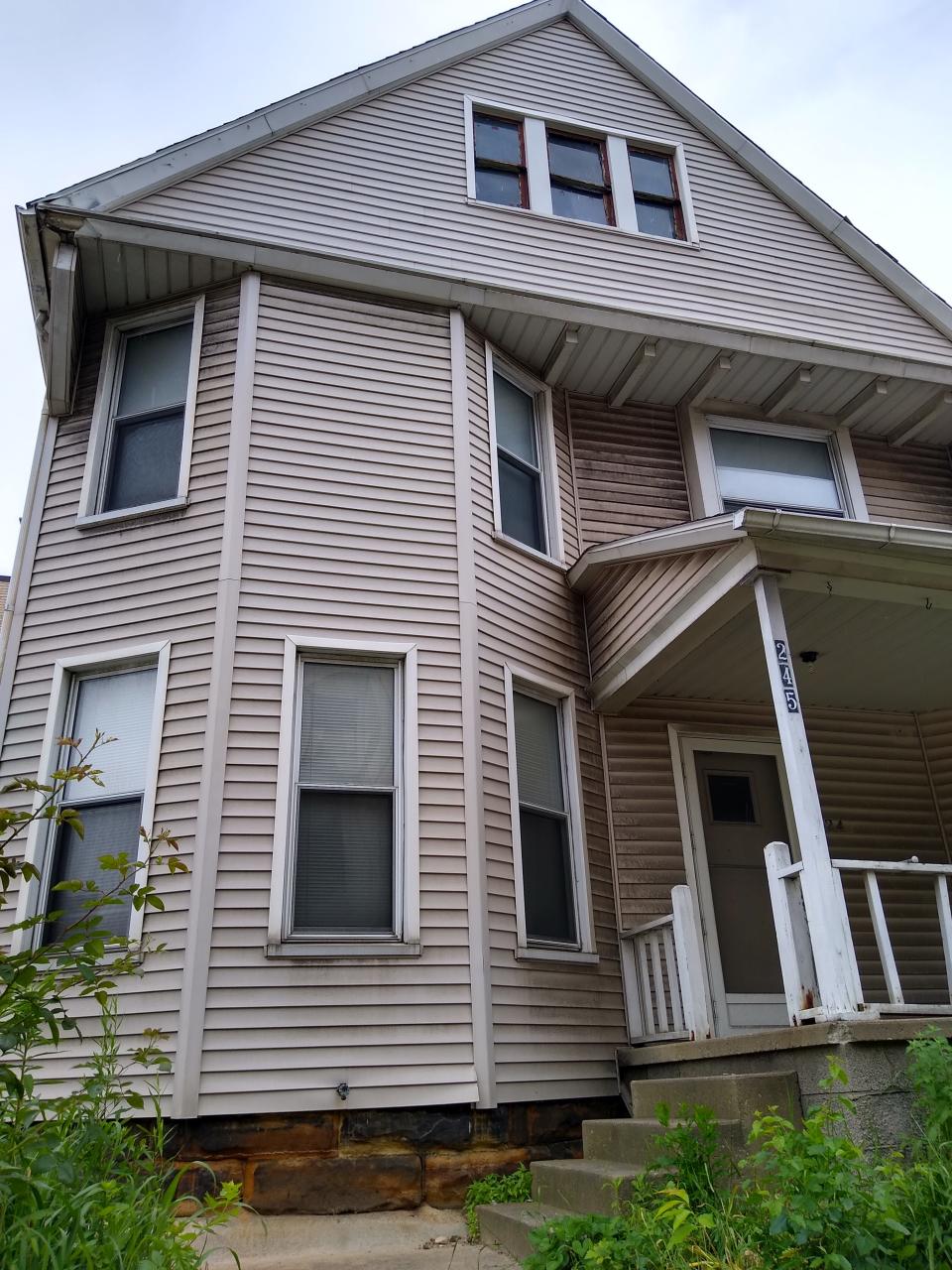
Companies have submitted bids on the demolition and the church is close to finalizing plans for the demolition project.
“We’re not quite ready to do it yet,” Zerucha said. “It’s not going to happen tomorrow, but it’s going to happen by the end of summer for sure.”
A few years ago, Harlan and Hengle took a tour of their old home. It had changed quite a bit since the 1970s.
1972: The year that rocked the Rubber Bowl
“We got to go upstairs and look around,” Harlan said. “We remembered our bedrooms and all that stuff. It was neat to see everything.”
Hengle hopes he can take one last peek before the demolition.
“I would love to get in again and take pictures,” he said.
Long after the houses are gone, the childhood memories will remain.
“It was just really a cool time,” Harlan said.
“It was fun,” Hengle said. “It was family.”
Mark J. Price can be reached at mprice@thebeaconjournal.com.
This article originally appeared on Akron Beacon Journal: St. Bernard Parish to raze two old houses in downtown Akron

